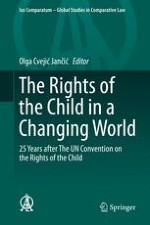This book deals with the implementation of the rights of the child as enshrined in the Convention on the Rights of the Child in 21 countries from Europe, Asia, Australia, and the USA. It gives an overview of the legal status of children regarding their most salient rights, such as the implementation of the best interest principle, the right of the child to know about of his/her origin, the right to be heard, to give medical consent, the right of the child in the field of employment, religious education of children, prohibition of physical punishment, protection of the child through deprivation of parental rights and in the case of inter-country adoption.
In the last 25 years since the Convention on the Rights of the Child was adopted, many States Parties to the Convention have made great efforts to pass legislation regulating the rights of the child, in their commitment to the improvement of the legal status of the child. However, is that enough for any child to live better, safer, and healthier? What are the practical effects of this international as well as many national instruments in the everyday life of children? Have there been any outcomes in terms of improvement of their status around the world, and improvement of the conditions under which they live, since the Convention entered into force? In tackling these questions, this work presents a comparative overview of the implementation of the Convention, and evaluates the results achieved.
